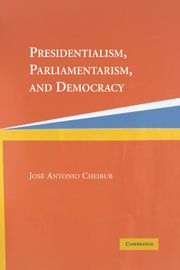Book contents
- Frontmatter
- Contents
- List of Figures and Tables
- Acknowledgments
- 1 INTRODUCTION
- 2 PRESIDENTIAL, PARLIAMENTARY, AND MIXED DEMOCRACIES
- 3 ARE THE INCENTIVES FOR COALITION FORMATION DIFFERENT IN PARLIAMENTARY AND PRESIDENTIAL DEMOCRACIES?
- 4 ARE COALITIONS RARE IN PRESIDENTIAL DEMOCRACIES?
- 5 PARTY DISCIPLINE AND FORM OF GOVERNMENT
- 6 WHAT MAKES PRESIDENTIAL DEMOCRACIES FRAGILE?
- 7 CONCLUSION
- Appendix: Definition and Sources of Variables
- References
- Index
- Cambridge Studies in Comparative Politics
4 - ARE COALITIONS RARE IN PRESIDENTIAL DEMOCRACIES?
Published online by Cambridge University Press: 05 June 2012
- Frontmatter
- Contents
- List of Figures and Tables
- Acknowledgments
- 1 INTRODUCTION
- 2 PRESIDENTIAL, PARLIAMENTARY, AND MIXED DEMOCRACIES
- 3 ARE THE INCENTIVES FOR COALITION FORMATION DIFFERENT IN PARLIAMENTARY AND PRESIDENTIAL DEMOCRACIES?
- 4 ARE COALITIONS RARE IN PRESIDENTIAL DEMOCRACIES?
- 5 PARTY DISCIPLINE AND FORM OF GOVERNMENT
- 6 WHAT MAKES PRESIDENTIAL DEMOCRACIES FRAGILE?
- 7 CONCLUSION
- Appendix: Definition and Sources of Variables
- References
- Index
- Cambridge Studies in Comparative Politics
Summary
Recall from Chapter 1 that, in the Linzian framework, presidents do not have an incentive to form coalitions while parties have an incentive to decline any coalition offers that are made. Thus the failure to form coalition governments is chronic in presidential systems and implies legislatively ineffective governments, deadlocks, and the eventual breakdown of the democratic regime. Our analysis in the previous chapter, however, suggested a different picture whereby: coalition governments are not uncommon in presidential democracies; there are conditions in presidential systems that will lead to the emergence of either a coalition government or a minority government supported by a legislative majority; and these conditions are identical for presidential and parliamentary systems, which means that minority governments in presidential systems – just as in parliamentary systems – do not necessarily spell disaster.
What do the data say? In this chapter I examine the patterns of coalition formation in both presidential and parliamentary democracies. I start by discussing the criteria used to observe coalition governments in democratic regimes. I then examine the actual pattern of coalition formation in democratic regimes and show that, although more frequent in parliamentary systems, coalition governments are not uncommon in presidential ones. I proceed to study the impact of the government status on the government's legislative effectiveness as well as on the probability of democratic breakdown. From this analysis it becomes clear that the status of the government – whether minority or majority, single-party or coalition – has no impact on its ability to govern.
- Type
- Chapter
- Information
- Presidentialism, Parliamentarism, and Democracy , pp. 68 - 115Publisher: Cambridge University PressPrint publication year: 2006

